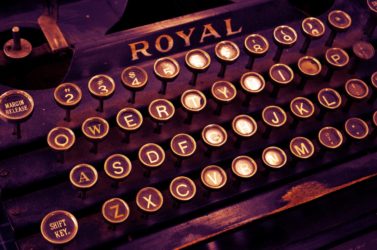
Do any of these names sound familiar? Remington, Olivetti, Royal, Smith Corona… If so, then you’re one of us old folks who learned to keyboard on a manual typewriter. It was a lot more energy-consuming than the fairy-soft touch of electronic keyboards that we all use today.
The history of manual typewriters began in 1575, when an Italian printmaker, Francesco Rampazetto, invented a machine to impress letters on papers. Not until 1714 did a Brit named Henry Mill take out a patent for a machine similar to a typewriter. In his wordy patent application, he wrote, “He hath by his great study and painese and expence invented and brought to perfection an artificial machine or method for impressing or transcribing of letters, one after another, as in writing, whereby all writing whatsoever may be engrossed in paper or parchment so neat and exact as not to be distinguished from print.”
In 1874, the first commercial typewriters were introduced in Europe and America. The invention of the typewriter was a work in progress by numerous inventors working independently or competing with each other. Historians have estimated that some form of manual typewriter was invented 52 times as inventors tried to create workable designs.
Electric typewriters began appearing in the early 1900s. One particular model, called the Varityper, used a narrow cylinder-like wheel that could be replaced to change the font. In 1941, IBM introduced the revolutionary concept of proportional spacing in electric typewriters, creating the appearance of a printed page.

Within a few years, the typewriter became an indispensable tool for practically all writing other than personal handwritten correspondence. Professional writers were among the early users of this wonderful new invention.
In 1883, Mark Twain was the first important writer to present a publisher with a typewritten manuscript: Life on the Mississippi. Ernest Hemingway used to write his books standing up in front of a Royal typewriter placed on bookshelf. J. R. R. Tolkien was also accustomed to typing from awkward positions: balancing his typewriter on his attic bed because there was no room on his desk. In his foreword to The Lord of the Rings, he wrote that “the whole story had to be typed and retyped by me, as the cost of professional typing by the ten-fingered was beyond my means.” Tom Robbins loved his Remington, a typewriter he bought to write Still Life with Woodpecker, but he eventually set it aside because “it is too complicated and inhuman for the writing of poetry.”
Jack Kerouac, a speed typist at 100 words per minute, typed On the Road on a roll of paper so he wouldn’t be interrupted by having to change the paper. His rapid work earned the famous rebuke from Truman Capote, “That’s not writing, it’s typing.” After completing the novel Beautiful Losers, Leonard Cohen is said to have flung his typewriter into the Aegean Sea.
Many writers found it hard to switch from typewriters to computers—among them Andy Rooney and William F. Buckley, Jr. More recently, David Sedaris found it so challenging that he continued to use a typewriter to write his famous essay collections Me Talk Pretty One Day.

Author Will Self explains why writers use a manual typewriter: “I think the computer user does their thinking on the screen, and the non-computer user is compelled, because he or she has to retype a whole text, to do a lot more thinking in the head.”

Connie Morrison
Yes, everyone our age has a typewriter in their past, and, probably, some old old whiteout. Oh, and carbon paper! How lucky we are now. Thanks for some memories, Barbara.
Mary Bast
Interesting, thinking about the difference in the writing process with typewriter vs. computer screen–though I think I’m much more willing to make significant changes when I can do it in the moment and not have to retype a whole page. Probably those who stuck with a typewriter were more confident in their first (second, third?) draft. Anyway, thanks for a thought-provoking blog post.
Joan Carter
I remember in college retyping an essay assignment six times on my Smith-Corona portable. My first draft always, even on a typewriter that’s supposed to make you think before you type, always needs reworking. Boy, do I appreciate a computer’s word-processing program!
Patience
i have a “Silent L. C. Smith & Corona Typewriters Inc.” which is not even close to silent. It was my grandfather’s. My husband Bob wrote Chickenhawk on a portable manual typewriter, which means all the rewrites actually were… Love those old things. Also Hi Barbara in case you remember me.